| Pages:
1
2
3
4
..
9 |
Sharksbaja
Elite Nomad
     
Posts: 5814
Registered: 9-7-2004
Location: Newport, Mulege B.C.S.
Member Is Offline
|
|
6 weeks after the flood
The next two pics show the growth that occured while between visits. All automatically watered. Nice to return to flourishing plants.
[Edited on 6-15-2008 by Sharksbaja]
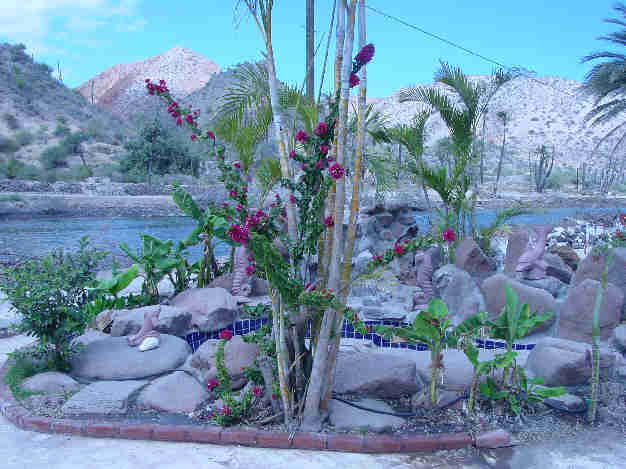
DON\'T SQUINT! Give yer eyes a break!
Try holding down [control] key and toggle the [+ and -] keys
Viva Mulege!
Nomads\' Sunsets
|
|
|
Sharksbaja
Elite Nomad
     
Posts: 5814
Registered: 9-7-2004
Location: Newport, Mulege B.C.S.
Member Is Offline
|
|
Three months later:
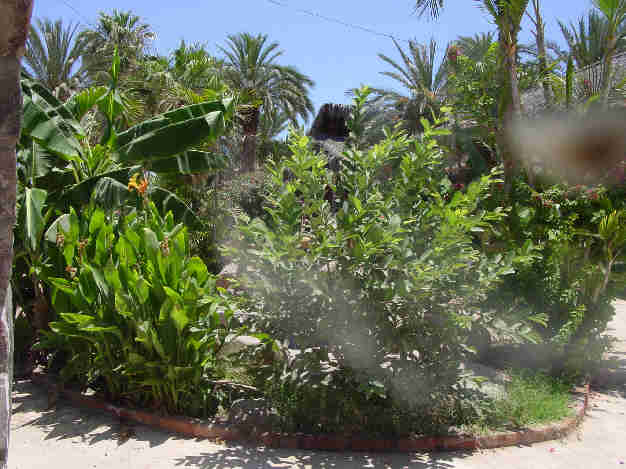
DON\'T SQUINT! Give yer eyes a break!
Try holding down [control] key and toggle the [+ and -] keys
Viva Mulege!
Nomads\' Sunsets
|
|
|
Bob and Susan
Elite Nomad
     
Posts: 8813
Registered: 8-20-2003
Location: Mulege BCS on the BAY
Member Is Offline
Mood: Full Time Residents
|
|
sharkman...saw your place from across the river yesterday...
looks pretty good
|
|
|
David K
Honored Nomad
        
Posts: 65403
Registered: 8-30-2002
Location: San Diego County
Member Is Online
Mood: Have Baja Fever
|
|
Great banana tree photo, Sharks...
Back in the 80's, I was an active member of the California Rare Fruit Growers after a friend turned me onto growing exotics in San Diego... Guavas,
Bananas, Passionfruit, etc. I was interested in the edible banana varieties... over 300 at the time and had a collection of over 30 banana varieties
growing in Vista.
Up near Santa Barbara, Doug Richardson had started his Seaside Banana Garden and received quite a bit of publicity for his exotic banana growing
exporting throughout the states (People Magazine, L.A. Times, etc.)... He and I traded varieties... The La Conchita landslide killed the lease he had
for the growing land along Hwy. 101.
Anyway, I wrote a couple of papers on banana varieties for California and how to grow them... they are online at the CRFG web site...
|
|
|
Pescador
Ultra Nomad
    
Posts: 3587
Registered: 10-17-2002
Location: Baja California Sur
Member Is Offline
|
|
David, thank you so much for going to the effort and taking the time to post this. The knowledge you have has taken years to develop and here you are
sharing it for free. I have saved it to Word and will now go through and modify my system. I had some plants that were simply not getting enough
water so I put in a sprinkler head but you are right, that is not the final way to go and controlled drip would be a lot better and not lime up like
the sprinkler heads are going to do.
|
|
|
David K
Honored Nomad
        
Posts: 65403
Registered: 8-30-2002
Location: San Diego County
Member Is Online
Mood: Have Baja Fever
|
|
| Quote: | Originally posted by Pescador
David, thank you so much for going to the effort and taking the time to post this. The knowledge you have has taken years to develop and here you are
sharing it for free. I have saved it to Word and will now go through and modify my system. I had some plants that were simply not getting enough
water so I put in a sprinkler head but you are right, that is not the final way to go and controlled drip would be a lot better and not lime up like
the sprinkler heads are going to do. |
You are quite welcome Pescador... Every property will have unique needs... and there is more than one way to irrigate an area or a plant. I hope all
with watering issues will come forward and I will try and help with what I have found works.
I have been installing, selling, teaching, designing irrigation systems since 1980 and pretty much try to keep a system as basic and simple as
possible, but using the best products and staying aware of new technology.
There is still a lot more information to add to this thread and one of them is operation of the drip system (how long/ how often or 'duration' and
'frequency').
Also, I can share some great news on a 'new to most' sprinkler that uses 1/3 the water of typical 15' sprays and yet has a radius of 20'... for lawns,
slopes, etc. I have been using it for over 5 years now with great results... so stay tuned!
Anyway, it is Father's Day and I am going to enjoy it with my son and daughter and Baja Angel. So, stay tuned for more later!
|
|
|
David K
Honored Nomad
        
Posts: 65403
Registered: 8-30-2002
Location: San Diego County
Member Is Online
Mood: Have Baja Fever
|
|
| Quote: | Originally posted by mtgoat666
| Quote: | Originally posted by David K
While using an anti siphon valve is recommended to protect residential water from possible contamination, some areas do not need an anti siphon valve.
[Edited on 6-14-2008 by David K] |
why would anybody not use an anti-siphon valve? |
When I said some areas do not need one, I meant 'to pass local codes'. In fact, you rarely see anti siphon valves outside of Southern California...
where there are so many sprinkler systems and people do not want to pay for backflow preventors that are usually required when using inline (non-anti
siphon) valves.
So, when using an in-line valve for irrigation, there is no preventing irrigation water from back siphoning into the source should there be an
unexpected pressure drop while your irrigation is running.
This pressure drop can happen when a water main breaks, the fire department hooks up nearby to put out a fire, etc. Water will flow from your property
towards the low pressure, and if there is fertilizer or chemicals in the soil or water, it will mix with the 'city' water... THAT'S NOT GOOD.
A back flow device, such as a backflow preventor, vacuum breaker, check valve or anti siphon valve that only allows water to flow in one direction
will prevent contamination of the city water (and perhaps your own home's water).
IF you wanted to inject chemicals or fertilizer into your irrigation water, then a reduced pressure principal backflow preventor is required here...
such as a Wilkins 975

Backflows have been used for commercial irrigation systems (so inline valves, installed below grade in a box can be used) and now are becoming common
for new residential homes. One less thing you can be sued for in the USA is contaminating your neighbor's water... with the backflow preventor
installed!
[Edited on 6-17-2008 by David K]
|
|
|
David K
Honored Nomad
        
Posts: 65403
Registered: 8-30-2002
Location: San Diego County
Member Is Online
Mood: Have Baja Fever
|
|
HOW MUCH WATER to apply and more info.
Here comes the fun part! Some science, so get a calculator!
The purpose of irrigation is to supply water to a plant in the amount it needs to live and grow... when natural water sources (rain, fog, ground
water) is not enough.
Water is lost from the plant through evapotranspiration... or water evaporating out of the plant and into the air. This water must be replaced before
too much is transpired out of the plant, along with some extra for growth and fruit production (if a fruiting plant).
Irrigation replaces lost water... and the plant absorbs water through its roots, underground. Drip irrigation applies water slowly on the ground so
more of the water applied actually can get to the roots.
Sprinklers throw water, under pressure, into the air (for distance)... Once in air some of that water is lost to evaporation (irrigate before it gets
hot), lost to wind (irrigate when there isn't any, like early morning), lost to runoff (high flow sprinklers or bubblers apply water faster than some
soils can absorb it), and just wasted (watering walls, sidewalks, roads, and other non-growing things).
Drip systems (when installed correctly) apply water to the ground, over the root system, slowly. No wind loss, little or no runoff, no or almost no
evaporation loss, no watering of undesired areas.
A correctly installed and operated sprinkler system has a 75-80% efficiency rating... that's it... Most I have seen are maybe 50% efficient (half the
water is not available to the plant, so running the sprinklers twice as long to keep plants/lawn alive is necessary).
A drip system has an 85-90% efficiency rating in warm to hot weather.
Picture this...
If you put a garden hose by a plant and just let the water trickle out as slowly as you can set it, that hose could run for hours and all the water
would be in the ground, below that plant.
If you opened up the hose to full and held it in one spot for more than a few seconds, all that water would be flooding around and running off
somewhere... most of the water going away from where you want it.
There you have drip vs. sprinkler.
Now, sprinklers have their place, to project water over large areas... and there are some great improvements in sprinkler technology that can cover a
large area, and use 2/3 less water than conventional sprays... more on that later!
continued...
|
|
|
David K
Honored Nomad
        
Posts: 65403
Registered: 8-30-2002
Location: San Diego County
Member Is Online
Mood: Have Baja Fever
|
|
Water Application Formula
Something to always remember: When a plant doubles in size, it needs 4 times the water...
A formula was discovered to figure how many gallons of water plants need from irrigation every day.
.623 X (.785 X DXD) X C X P
______________________
E
Not sure how this will look once I hit post, but DXD is the plant canopy diameter, squared. C is the climate factor. P is the plant use coefficient.
Multiply the top line together and the divide the answer by E which is the irrigation efficiency.
D = Canopy Diameter in feet.
C = Climate Factor : .15 for under 70°F. .25 for 70°-80°. .35 for 80°-100°. .45 for over 100°F.
P = Plant Use Coefficient: .20 for low water use plants, .50 for average water use plants, .65 for citrus and avocado, .70 for high water use shrubs,
.75 for deciduous fruit trees, .90 for high water use trees.
E = Irrigation Efficiency: .90 for drip in warm weather, .85 for hot weather. .80 for sprinklers in warm weather, .75 for hot weather. Add .05 to
above figures for cool weather.
-------------------------------------------------------------------------------
okay, now we have a daily gallon amount... but, we usually do not water every day (only in extreme heat)... so, if your irrigation is watering every 3
days, multiply the figure by 3 and apply that amount of water.
ALL irrigation products that flow water have the flow rate provided in gallons per hour (GPH) or gallons per minute (GPM) at various pressures (PSI),
by their manufacturer.
Now, to see the formula in operation!
A 10' diameter orange tree, during a 75° average week, irrigated with a drip system:
.623 X .785 X (10X10) X .25 X .65 = 7.95 divided by .90 = 8.83 gallons per day... If you irrigate once a week, then 8.83 X 7 = 62 GALLONS per week for
that 10 ft. orange tree on a drip system.
If you have 30 feet of Netafim (0.6 GPH @ 12" spacing) emitterline around that 10' tree, then the 30 emitters flow 18 GPH. The tree needs 62 gallons.
62 divided by 18 = 3.5 hours (always round up) of irrigation.
That same tree if watered with 'good' sprinklers would need 9.93 gallons per day or 70 gallons per week... A 10' half circle spray flows about 1 GPM.
70 divided by 1 = 70 minutes of irrigation... that much time may very well lead to water flowing far from the trees in hard or steep terrain... thus
multiple shorter runs may need to be used.
I have some illustrations from my published and unpublished irrigation guide books... I might try and post here...
To be continued!
[Edited on 12-13-2019 by David K]
|
|
|
David K
Honored Nomad
        
Posts: 65403
Registered: 8-30-2002
Location: San Diego County
Member Is Online
Mood: Have Baja Fever
|
|
Here are some pages from the unpublished 'Irrigation Design: Book 3 (Drip Irrigation)' that we wrote after we published 'Irrigation Design: Book 1
(Design Flow and Operating Pressure)'

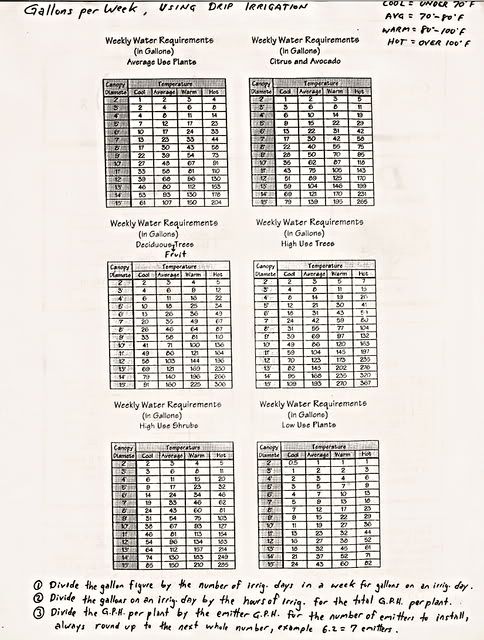
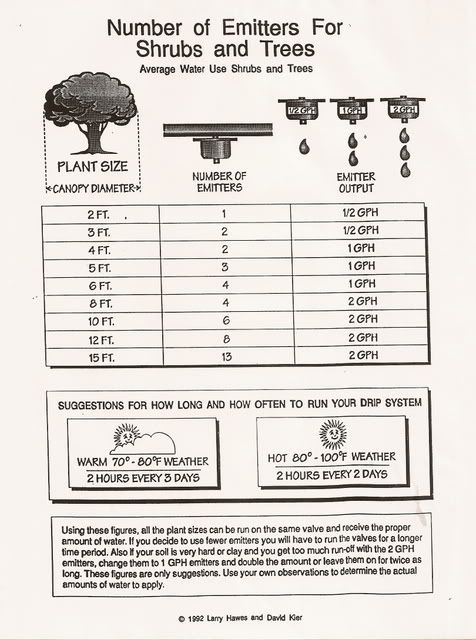

|
|
|
David K
Honored Nomad
        
Posts: 65403
Registered: 8-30-2002
Location: San Diego County
Member Is Online
Mood: Have Baja Fever
|
|
Book 1
Larry and I worked many evenings on Book 1... I had most of the irrigation details and Larry had computer graphic skills and also being a landscaper,
had installed irrigation... I met him as he was a customer where I worked and sold irrigation... back in 1992.
Anyway, there was always some mystery into how water works and acts in irrigation and we wanted to help shed some light on how water reacts to pipe
sizes, valves, pressure, etc.
The information was out there, but usually in big, complex manuals that most landscapers and homeowners would never see.
We took the details and put into a simple, reusable guide which was to be one of three books. Book 2 was to be about sprinkler design and book 3 about
drip/ micro irrigation design.
We published Book 1 and it is still in print... last I heard, as Larry has done the publishing. It became a 'best seller' in one horticultural catalog
of tree books and some colleges have used them for landscape classes...
Book 1 took so much energy and time from us, who worked during the days, that we never went on to publish the other two books...
Here is the front and back of Book 1...

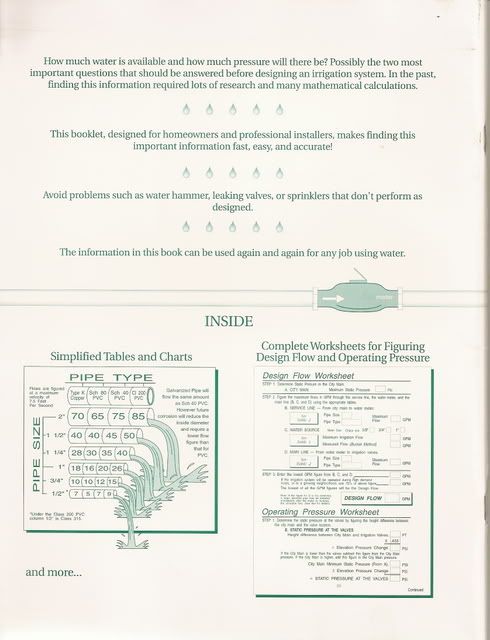
|
|
|
David K
Honored Nomad
        
Posts: 65403
Registered: 8-30-2002
Location: San Diego County
Member Is Online
Mood: Have Baja Fever
|
|
Anyway, this thread is here to help you with irrigating your landscape/ garden/ trees... so please feel free to post questions or u2u if you prefer.
|
|
|
Jack Swords
Super Nomad
   
Posts: 1095
Registered: 8-30-2002
Location: Nipomo, CA/La Paz, BCS
Member Is Offline
|
|
Well done David. Now, with the math, I can see the logical progression of water needs for the plants. I always just used powers of observation. A
question that may occur to others: In Nipomo our soil is 300 feet of dune sand. A dripper "stovepipes" straight down. In Todos Santos a 1 gallon
dripper ran off the plant's location on a slight hill. Seems like the math doesn't address remedies for these distinct differences. Obviously in the
dune sand more emitters also means wasted water as it goes straight down past the plant's roots. In heavy soil runoff is also wasted. Any
suggestions?
|
|
|
David K
Honored Nomad
        
Posts: 65403
Registered: 8-30-2002
Location: San Diego County
Member Is Online
Mood: Have Baja Fever
|
|
| Quote: | Originally posted by Jack Swords
Well done David. Now, with the math, I can see the logical progression of water needs for the plants. I always just used powers of observation. A
question that may occur to others: In Nipomo our soil is 300 feet of dune sand. A dripper "stovepipes" straight down. In Todos Santos a 1 gallon
dripper ran off the plant's location on a slight hill. Seems like the math doesn't address remedies for these distinct differences. Obviously in the
dune sand more emitters also means wasted water as it goes straight down past the plant's roots. In heavy soil runoff is also wasted. Any
suggestions? |
Good question Jack...
On the page showing emitter placement, Larry added the text below the illustrations that addressed the clay soil problem. Since that time (16 years
ago) I have used much more emitterline than single emitters for drip systems... here's why emitterline is better in both of your examples:
CLAY (hard to wet soil) This is where the slower you apply water the easier it can be absorbed benefit of drip comes in. The emitterline I use is the
1/2 GPH (0.61 actually) per foot type... a 1/2 GPH drip gets into clay better than 1 or 2 GPH drip rates... So less chance of runoff... Make a basin
if you must corral the water in the root zone... Usually basins are not needed for drip irigation, but the water is not doing any good if it isn't
over the root zone.
SAND (water doesn't spread well) As Jack mentioned, water will 'stovepipe' straight down in sandy soil, and miss most of the roots if you use standard
emitters and emitter placement. Water below the root zone isn't doing the plant much good. Here again, emitterline (dripperline) with emitters every
12" in the tube has many, many more wetting points around plants than a few seperate emitters. When the system is operated 1-2 hours (typical) the wet
spots all blend together and make a wet strip a foot (+/-) wide on the surface, and that wet area is wider underground as capillary action pulls the
water sideways as it moves down. In sany soil that is less true... but still we have much more area covered with the dripperline.
Remember, the above posted guides are just that, a guide to help you with irrigation that has worked for us... You MUST use your own observations and
common sense at the installation site to adjust for your local conditions!
With drip, you control how much water a plant gets... if it looks dry, run the system longer... it's in your hands! When plants grow, the irrigation
must as well... Install a system that will meet the needs of full grown, mature plants and any possible additions.
3/4" PVC pipe and the drip control valve can flow 8 GPM or 480 GPH (if your source is at least that much available).
1/2" poly hose can flow 4 GPM or 240 GPH max. (ie. 120 2 GPH emitters or sections of emitterline that total nearly 400').
1/2" emitterline (0.61 GPH/ 12" spacing) can run up to 300' from the point of connection (3 GPM or 180 GPH).
The slower you apply water, the more it will benefit you in savings and results!
|
|
|
mtgoat666
Platinum Nomad
       
Posts: 20332
Registered: 9-16-2006
Location: San Diego
Member Is Offline
Mood: Hot n spicy
|
|
| Quote: | Originally posted by David K
Here comes the fun part! Some science, so get a calculator!
The purpose of irrigation is to supply water to a plant in the amount it needs to live and grow... when natural water sources (rain, fog, ground
water) is not enough.
....
There you have drip vs. sprinkler.
|
i usually plant natives, and all my experts tell me that drip irrigation is bad for natives. however, drip sounds good for people growing temperate
and tropical plants in the desert.
|
|
|
thebajarunner
Ultra Nomad
    
Posts: 3754
Registered: 9-8-2003
Location: Arizona....."Free at last from crumbling Cali
Member Is Offline
Mood: muy amable
|
|
Great stuff, as usual, David,
Up here we have to constantly monitor the systems because various 'critters', generally coyotes, will gnaw through and tap into the water flow, which
of course creates mini-geysers in the system.
Other than regular visual inspection there is not much remedy.
(other than a well placed .22 slug, now and then)(into the critter, not into the drip system)
|
|
|
David K
Honored Nomad
        
Posts: 65403
Registered: 8-30-2002
Location: San Diego County
Member Is Online
Mood: Have Baja Fever
|
|
| Quote: | Originally posted by mtgoat666
| Quote: | Originally posted by David K
Here comes the fun part! Some science, so get a calculator!
The purpose of irrigation is to supply water to a plant in the amount it needs to live and grow... when natural water sources (rain, fog, ground
water) is not enough.
....
There you have drip vs. sprinkler.
|
i usually plant natives, and all my experts tell me that drip irrigation is bad for natives. however, drip sounds good for people growing temperate
and tropical plants in the desert. |
Interesting... since a plant (native or import) cannot tell how the water is getting into the soil, it doesn't know if it is from a drip or other
system. It can only repsond to the quantity of water (too much or too little or just right)...
So, drip irrigation in of itself cannot be 'bad' but the installation and operation of a drip system can be.
Not enough emitters per plant, poor placement of emitters, incorrect operating duration and frequency is what can be bad... the water is the same once
in the root zone.
All this I am posting is to show you how to correctly install and operate drip irrigation. Please ask your 'experts' to read what I have shared and
perhaps they will either be enlightened or can share with me what 28 years experience hasn't yet... None of us are too old to learn, right?
|
|
|
David K
Honored Nomad
        
Posts: 65403
Registered: 8-30-2002
Location: San Diego County
Member Is Online
Mood: Have Baja Fever
|
|
| Quote: | Originally posted by thebajarunner
Great stuff, as usual, David,
Up here we have to constantly monitor the systems because various 'critters', generally coyotes, will gnaw through and tap into the water flow, which
of course creates mini-geysers in the system.
Other than regular visual inspection there is not much remedy.
(other than a well placed .22 slug, now and then)(into the critter, not into the drip system) |
Thank you Dick... if the lines can be buried in animal problem areas, then better... A bowl/ bucket of water with an emitter in it (to keep it full)
will give the coyotes the water they seek, without damage to the tubes... hopefully!
|
|
|
David K
Honored Nomad
        
Posts: 65403
Registered: 8-30-2002
Location: San Diego County
Member Is Online
Mood: Have Baja Fever
|
|
The Next Generation in Sprinklers!
This is something I am very excited about, and since they were introduced into the landscape irrigation world about 6 years ago, I have been using
them with fantastic results.
The MP Rotator is a multi stream rotating sprinkler the size of a spray nozzle (small) and fits right into typical Rainbird or Toro brand pop up
sprinklers or shrub riser adapters.
The 20' (MP-2000) model uses 1/3 the water of a standard 15' spray, yet gives more coverage. With the much lower flow rate, low pressure problems are
solved... and water is more efficiently utilized.
The low pressure, low water supply Baja home garden now has hope for making that little bit of water go further than ever before!
Originally available in one size (20' radius), the last 2 years has seen the introduction of a 14' radius and a 30' radius model with a special
45°-105° corner, and 5' wide strip models.
Here are a couple of real short videos (7 seconds) that show an MP pop up and an MP riser coming on.
Next generation sprinklers, Pop up
Next generation sprinklers, on a riser
Look to see these in the future at Baja Cactus, El Rosario wetting the nature trail and catus garden Antonio plans for the hillside.
www.mprotator.com for all the scoop
Now, please feel free to ask for help or advice!
[Edited on 12-13-2019 by David K]
|
|
|
Bob and Susan
Elite Nomad
     
Posts: 8813
Registered: 8-20-2003
Location: Mulege BCS on the BAY
Member Is Offline
Mood: Full Time Residents
|
|
these "new generation" sprinklers seem to have ALOT of moving parts
with our REALLY hard water how would these hold up?
i kinda of disagree with davidk about the sprinkler valves...
i've used the "cheap" $12 anti-siphon valves from home depot for years and they hold up...
the only thing i've had go out would be the selonoid (on a VERY few) years later and that's just a screw in "easy fix"
david is a professional and MUST guarentee his work so he uses the BEST and most expensive
for us "simpletons" we can easily use the cheaper "off the shelf" items to grow our plants
you really don't need to spend a fortune on sprinklers to water...
|
|
|
| Pages:
1
2
3
4
..
9 |
|

